Terry Madewell, a frequent contributor to CatfishNOW, had never used this particular light-tackle technique for catfish. But he and his daughter Melissa got an excellent taste of how it works fishing with the author earlier this year. (Photo: Capt. Richard Simms)
Catch the Light-Tackle Blues
By Capt. Richard Simms
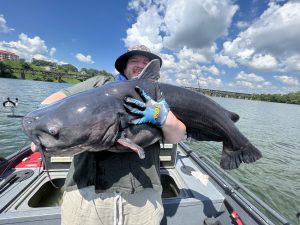
Terry Madewell is a well-known outdoor journalist. He has catfished all across the country, and his wise words are often part of this very magazine—CatfishNOW.
“I’ve fished a lot of different places and different ways, but this is a first for me,” Terry admitted.
It was April. We were free drifting in the tailwaters downstream from Chickamauga Dam on the Tennessee River. We had 3/0 Kahle hooks baited with chicken breast, using no sinkers, in 10 to 20 feet of water on standard spinning rods.
A few short minutes later, Terry’s rod tip bounced. He set the hook, and his medium action spinning rod bowed over like a horseshoe. Otherwise, not much happened, and for a split-second, Terry wondered if he may have snagged the bottom of the Tennessee River. Seconds later, however, his spinning reel drag began to scream. The line ripping off the reel sounded like mad hornets. For a fishing guide, there is no sweeter sound than the distinct buzz of braided line screaming off the spool in the wrong direction.
“That’s going to be a good one,” I exclaimed.
Then suddenly, Terry’s daughter Melissa let out a little yelp and said, “Oh my,” or words to that effect. I looked over and now Melissa’s rod was doubled over as well.
With a smile, I added, “This is going to be some fun here folks. Y’all just have to figure it out and keep those lines apart.”
The pair of catfishing pros soon had a combined 35 pounds of catfish in the boat and CPR’d (Caught, Photographed and Released). However, by day’s end, they easily boated enough smaller cats to have held a hefty fish fry for a large family, maybe several families.
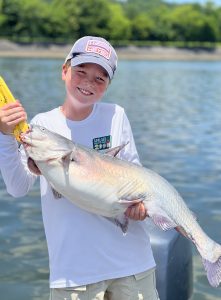
We were using one of my favorite catfishing techniques. We refer to it as our “light-tackle drift.” Our rods are standard 6- to 7-foot spinning rods, usually medium action with a standard spinning reel loaded with monofilament as light as 8-pound-test up to 20-pound-test braided line. It is the same equipment the majority of fishermen might use for bass or even bluegills. The only difference is we have caught catfish up to 70 pounds plus on such gear. One of my clients even holds a catch-and-release world record from the National Fresh Water Fishing Hall of Fame for the biggest blue cat taken on 10-pound test line.
Capt. Mike Mitchell, owner of SouthernCats Guide Service, is one of the most well-known trophy catfish guides in the Southeast. During his guiding career, Capt. Mitchell has always matched his tackle to the fish he pursues, most often using rods, reels and line seemingly better suited for deep-sea fishing. It is absolutely true that clients stand a far better chance of successfully landing the fish of a lifetime using heavy tackle
Recently, however, Capt. Mitchell has started using his own light-tackle technique as well.
“Light tackle really is a ton of fun,” said Capt. Mitchell. “Presentation is a big plus. It’s so natural, and you just seem to catch more fish.”
The typical blue catfish we routinely catch on the Tennessee River weighs between 5 and 10 pounds. When you first hook a catfish that size on light tackle, you’re in for a fight. But hook anything larger and things get way more intense real fast.
Capt. Mitchell says he is typically using spinning gear on medium- or medium-heavy-action rods. He says his reels are spooled with 10- or 12-pound-test monofilament. But he adds a two-foot section of 100-pound-test hook leader.
On light line with light tackle, you cannot overpower a trophy catfish. Your goal is to simply outlast him. That’s when I use my favorite saying, telling clients, “Remember, it’s patience over power.”
However, we also tell clients, “When you hook a big cat on relatively light tackle, you are dancing with the devil.” That means there is a greater chance of losing the battle.
“You do lose some fish occasionally due to the lighter line,” said Capt. Mitchell. “I push my stuff as hard as I can and break a few fish off because it’s very rocky. But with an experienced angler, it’s not that common you break them off. It just takes a lot longer to land bigger fish, and you just have to focus on that fish and do everything right to land it.”
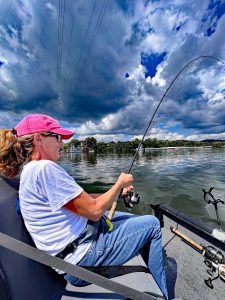
In many cases, the light-tackle bite can be more about quantity than quality. We like for our clients to have bent poles, and that’s where the light tackle excels. On an average trip, putting 50-100 pounds of catfish in the livewell is typical. And on good days, 200 pounds plus is a good possibility.
Where to Fish
We routinely fish the Tennessee River in the tailwaters of Tennessee Valley Authority (TVA) dams in east Tennessee or north Alabama. Those systems are more like true riverine systems when compared to still-water reservoirs. However, the river current is dictated by the amount of water TVA is releasing through the dam to generate electricity.
Those tailwater areas are also relatively shallow. At times beneath Chickamauga Dam, we are fishing areas where the water might only be six to 10 feet deep. Capt. Mitchell says he does best in five to 10 feet of water, sometimes going up to 20 feet but typically fishing areas where standard big-water catfishing techniques simply are not as effective.
How To
The rig is exceedingly simple. These days I typically use 20-pound-test braided main line with a 20-pound mono shock leader connected via a two-way swivel. I still use the mono shock leader even with the braid because the mono withstands abrasions better and the swivels help avoid line twist.
Capt. Mitchell uses a far heavier shock leader as his north Alabama tailwaters have much more rock than our tailwaters farther upstream.
My preferred hook is a 3/0 Kahle-style from Boss Kat. The flat profile Kahle-style hook hangs on the bottom less frequently than a standard J-hook. Capt. Mitchell says he routinely uses 8/0 and 5/0 Boss Kat circle hooks.
The true secret of the technique is weight, or better put, the lack of weight. I always tell folks to “use the LEAST amount of weight possible.” That includes sometimes using no weight. I prefer fishing with chunks of plain chicken breast, roughly the size of a ping pong ball or a golf ball. When fished on a slack line, the chicken breast is dense enough to slowly sink of its on accord.
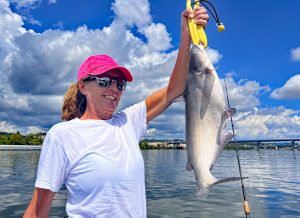
We are firmly of the opinion that presentation matters a great deal. A free-drifting bait better imitates the food the catfish are used to seeing drifting along in the current.
The perfect analogy is a feather. When you drop a plain feather, it drifts and floats down naturally. Attach a split shot to it, however, and it simply plummets to earth and looks nothing like a feather.
The same is true of your bait. The less weight attached, the more naturally it drifts. And presentation matters, a lot.
In our tailwaters we cast it directly upstream of the boat and drift at the exact same speed as the current. On a free drift on a slack line, the chicken sinks naturally. I’ve hung the bottom with weightless chicken as deep as 30 feet, as well as some big cats.
In his tailwaters with more slack-water areas, Capt. Mitchell says, “Light tackle allows me to have clients cast and retrieve with ease, giving the bait that very natural presentation. We are working small baits around big rocks, and it’s really a lot like working a Texas-rigged worm for bass.”
Why Not Heavier Line?
The principal of the light-tackle technique is to provide a more natural bait presentation. Using heavier line or more weight greatly restricts the “floating feather” qualities of your bait drifting downstream. Without question, lighter, smaller-diameter lines and less weight result in more bites.
What to Look For
I routinely tell clients that catfish are really like trout. In a riverine situation, they prefer resting in “ambush points.” On a shallow trout stream, it is easy to see those places where there might be a large boulder, a series of small rocks or a riffle emptying into deep pool. Catfish look for the same type areas except in deeper water. You can’t see them without using your electronics.
When To
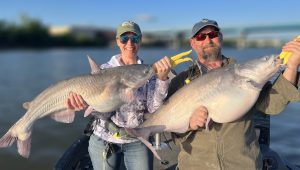
The light-tackle technique is not normally a cold-weather technique. Our best light-tackle bite typically begins in late March or April and continues throughout the warm-weather months.
Capt. Mitchell said, “I use it mostly May to July. Around the spawn seems to be best. When it’s tough you can still get on good numbers and the occasional big one.”
Sometimes the hotter it gets the better the fishing. That, in part, is because TVA routinely needs to generate more power for air conditioners when it is hot and releases more water through the dams. More current often means more active fish.
Don’t Be Afraid to Downsize
Many catfishermen like catfishing specifically because they like pursuing monsters 50-pounds and up. Traditionally those folks use huge tackle. We do that, too.
However, those anglers might be missing out on a tremendous amount of action and fun. That is especially true if you are taking youngsters or inexperienced anglers that definitely don’t enjoy camping out for hours waiting on a big-fish bite.
And there are times when downsizing your tackle might even be the best way to snag a monster.
(Capt. Richard Simms is the editor of or our sister publication, CrappieNOW magazine. He is also a “semi-retired” fishing guide on the Tennessee River and owner of Scenic City Fishing Charters. Formerly he was a game warden for the Tennessee Wildlife Resources Agency before becoming a photographer and PR guy for TWRA. That lead to a 30-year career as a broadcast journalist and freelance outdoor writer. Check out his book, “An Outdoor State of Mind.”)



